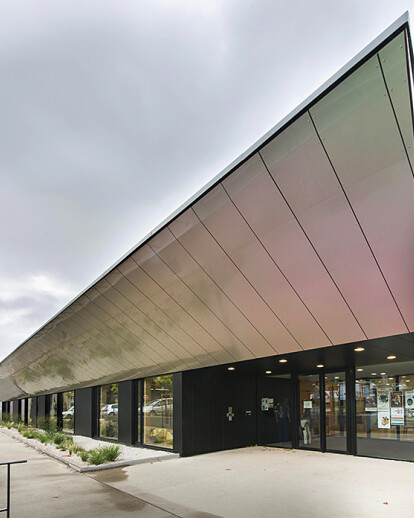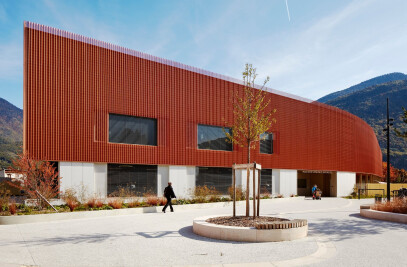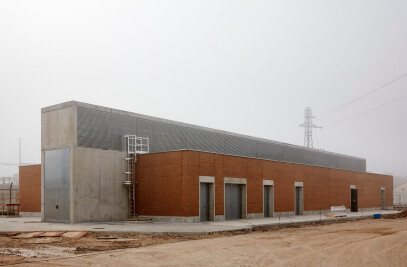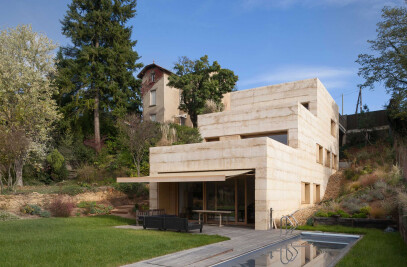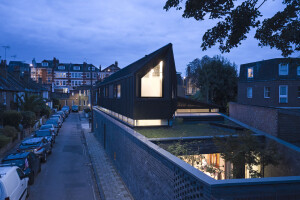A chameleonic project
The Early Childhood Center in Autun is something of an architectural exception in terms of the production of the agency Tectoniques. A single-storey right-angle building, topped off with a broad, iridescent, reflective cap, it is a surprising presence in the surrounding environment and frames, in a playful and joyful manner, an urban landscape which itself is poorly established.
The angular, dark exterior contrasts with a soft, rounded, colorful interior with some facades opening out onto the exterior and others kept opaque for the purposes of privacy.
This generous facility covers 1,400m2 and contains a day nursery with 90 places (divided into three sections) and a center providing services for child minders. Spacious and comfortable for its users, the building creates a feeling of well-being both inside and out.
From the "Crayons Verts" to "Bel Gazou"
"Bel Gazou" - the name give to the center in Autun by the local community - has added to the agency’s experience in terms of early childhood facilities, following on from its work on the "Crayons Verts" project in Saint-Didier-de-Formans in the Ain region.
The two projects have a certain number of similarities. The briefs were identical, and in both cases were built in unattractive environments: the rundown village center in Saint-Didier, and a platform on the outskirts of Autun. The construction protocol was also comparable with a wood construction encompassed by a single concrete shell. The typology remains the same too with a single-storey building organized around a wide, bright internal hallway. Finally, the architectural positioning is also similar: abstract and silent from afar, fun and figurative up close. Only the geometrical composition differs as the project in Saint-Didier is all curves whilst the project in Autun is all angles.
About turn
In Autun, the building is located at the boundary between the historical centre and the city suburbs, characterized by 1970s high rises, surrounded by ill-defined public spaces and large, mostly vacant, parking lots. The extremely narrow plot of land has a complex shape. There is nothing to work off in the surrounding area, no features which lend themselves to dialogue or complicity.
The project has therefore taken a gamble on what is, for the moment, a solitary initiative. It creates its own setting, in the hope that a dynamic will be developed through the future changes made to the area, notably regarding the requalification of the surrounding public spaces.
A bespoke project, it "weaves" around the existing spaces and develops two large, perpendicular bars open onto the local neighborhoods to the south and the east.
The entrance forecourt is situated at the intersection where the two buildings meet. Historically, this location corresponds to the exact point at which the decumanus and cardo met in Roman times. Archeological excavations have therefore been carried out on the site and need to be protected from any deep construction work. This imposed the need for very superficial foundations, ironically making the building’s long-term future entirely relative.
Silent from afar / playful up close
The two main buildings are built on a plot of land which lies slightly lower than the surrounding area. The overall impression created is one of silence, deliberately tempering the building's presence in the urban landscape. Viewed from afar the project looks like a fold in the landscape forming an abstract shape. Its real dimensions are only clearly visible up close.
From this perspective, the scale seems immediately much larger, the texture much lighter and the architecture much brighter. The reflective facade projects moving images and colors. The openings are both high and wide, drawing the eye towards the warm, bright interiors.
Iridescent and gleaming
The large overhang which protects the spaces immediately surrounding the building is composed of sandwich panels of bright polished aluminum. It sets the tone for the whole project and for the entrance area in particular where it intensifies the effect of perspective. The angle has been determined to regulate the amount of direct sunlight.
As well as this protective function it also constitutes a scenographic tool, reflecting an ever-changing series of images and colors, sometimes clear, sometimes abstract, tinted pink or green depending on the light and the angle.
This dynamic and playful presence accompanies the children throughout their day, giving off a strong impression of vitality. It is accentuated by the neutral facades covered in dark, absorbing panels, fitted with charcoal grey blinds and woodwork.
There is a very stark contrast between the interior and the exterior, emphasized by the choice of colors, materials and shapes (dark outside / bright inside; iridescent, gleaming finishes outside / mat, natural finishes inside; angular outside / rounded inside). This simple effect of relativity accentuates the calm, benevolent atmosphere found inside the building.
An active central nerve and cellular niches
The internal organization is simple, a series of generously-proportioned spaces follow on from each other with total transparency making them easily identifiable. The careful consideration given to the ergonomics, and the harmonious shades of color used, are perfectly adapted to a facility for children and infants. From the large entrance hall situated at the intersection between the two programs, there are views through both buildings. The center providing services for child minders is located to the west, overlooking the forecourt, while the day nursery is situated to the north with views of the garden. The program is connected throughout by a long, continuous hallway, a space of connections, transition, of life which forms the spinal column of the project.
Along this central nerve, a series of cellular rooms accommodate the different activities associated with caring for groups of children. The activity rooms which look out across the surrounding area are disposed along the length of the exterior facades. The adjoining bathrooms form an interface with the dormitories. The whole forms a series of communicating cells, offering a variety of combinations for opening up or closing off the different spaces according to the need for increased privacy or increased space at different times of the day.
The administrative offices, technical rooms, dining hall and kitchen (meals are prepared on site) run the length of the interior facade, lit with natural light from the inner patios.
A bright, colorful atmosphere is created from the interplay between three materials: wood, used with a natural finish for the ceilings and visible structures; concrete, left unfinished, for the large stabilizing shell that covers the whole building; and plasterboard panels painted in four colors, like the furniture, partly supplied by the manufacturer Tolix (based in Autun).
Construction principles faithful to Tectoniques’ convictions
From a construction perspective the project conforms to the Tectoniques agency’s signature principles, with a few specificities. The structure is mixed concrete and wood. The flooring is a concrete slab on a micropile foundation (0.70m depth due to the archeological excavations). A large white concrete shell built along the central spine of the building provides it with the required stability and thermal inertia. The whole structure and framework are made of wood, with a 40-cm insulating compound composed of cellulose wadding and wood fibers. The green roof is covered with pre-grown rolls of turf and is free of technical installations.
Inside there are no pretences, the materials are found where they needed. For example, the wooden ceilings in the activity rooms are exposed and also act as an acoustic ceiling. The same is true for the bathrooms with their mineralized wood fiber drop ceilings set out in a very precise layout.
Throughout the building efforts have been made to ensure maximum amounts of natural light. Firstly, the windows in the activity rooms and opening onto the patio run the full height of the walls, creating what appear to be landscape paintings. The sawtooth openings in the roof provide overhead lighting as required at the heart of the building.
In terms of energy efficiency, the building complies with the 2012 thermal regulations in force in France. The building’s central concrete shell helps increase the thermal inertia. The large openings in the long facades are compensated by their careful orientation and the use of extensive insulation. The windows are protected by external venetian blinds.
In terms of support systems, the double flow ventilation guarantees the quality, temperature and renewal of the air. In the large rooms, destratification is achieved using large ceiling-mounted fans on a slow speed setting to minimize noise. The air treatment system is backed up with additional radiators. Two gas-fueled condensation boilers are used for heating purposes, one for each building as the needs differ between the two.
Motorized opening processes are used to provide natural ventilation through the facades and the sawtooth openings in the roof, as well as providing night-time ventilation during the summer months.
The green roof provides additional insulation over a vast surface and also serves to absorb some of the rainwater. The fact that the materials used, mainly wood-based, were bio-based was a key factor in their selection.
